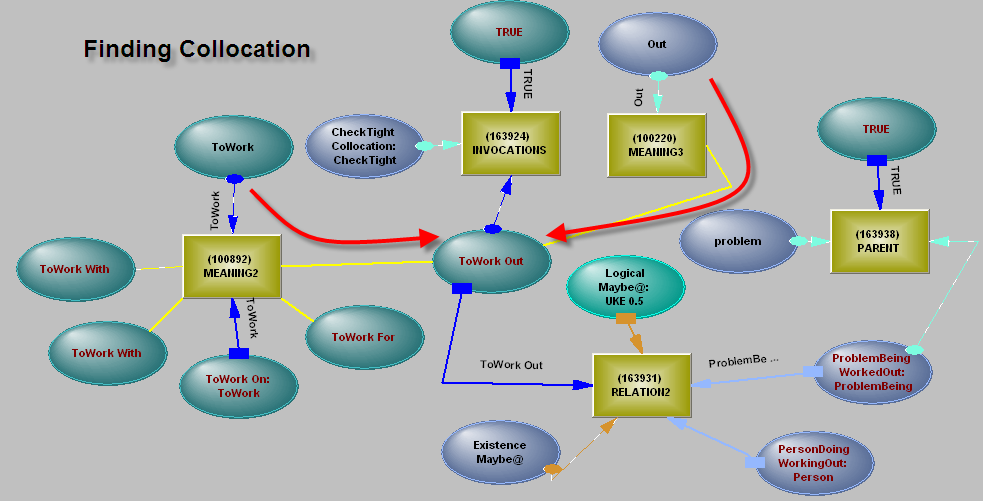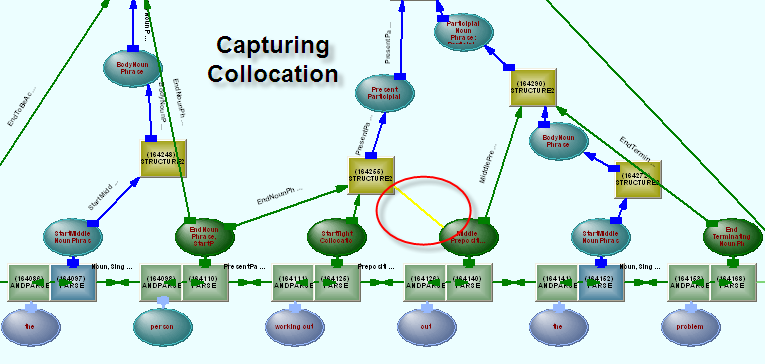
Verbs such as
Strike down
Shut up
Work out
are formed from an existing verb and a preposition, and introduce a new meaning. We can't assume the meaning without checking on the objects being related, as there may be several different meanings
He worked out of a small office
He worked out at the gym
He worked out the problem in record time
If we can find a tightly collocated verb/preposition, there seems no need to create a prepositional chain, as it would be simpler to see the verb/preposition as a single object, and then the object of the verb. Similarly, it would be easier to collapse a participial and a preposition in a prepositional chain.
We can note the juxtaposition of verb or participle and preposition, check for a tight correlation and create a CollocatedPrepositional. When we have the verb, the CollocatedPrepositional and the object, we check that it matches the relation modelling, convert the verb and the prepositional into a verb, or turn it back into a prepositional if it does not match.
We have several cases
He struck down the statute – active verb
The statute was struck down – passive verb
He ended the case, striking down the statute in the process – present participle
The statute, struck down by the judge, was reinstated. – past participle
Striking down the statute was commendable. – participle as subject
We find the possibility of a collocation in the parse chain using
STRUCTURE1(CheckTightCollocation,{Participle, Preposition})
In "The person working on the problem", the structure would recognise "working" and "on" and create a CheckTightCollocation in the parse structure.
When the structure CheckTightCollocation is created, it uses the relation and preposition to look for a tight collocation. It moves up to the relation "ToWork" and the preposition "On" – the word objects in the parse chain are instantiations of the dictionary objects.

The particular collocation (ToWorkOut") is an invocation of TightCollocation, so the prepositional becomes a CollocatedPrepositional – we cannot conclude it is verified until the semantic modelling around the collocation is checked, and for that we need the subject and object of the relation.
STRUCTURE1(CollocatedPrepositional,{StartTightCollocation, NOTWITH(MiddleBetweenAndPhrase, StartPrepositionalNounPhrase)})
When other structures around the collocation have been identified, a structure such as
STRUCTURE1(CheckCollocatedVerbPhrase,{NounPhrase, PresentParticipial, CollocatedPrepositional, NounPhrase})
is used to check the collocation.

The semantic modelling for the collocation is present in the parameters for the ToWorkOut relation - the object has to be a child of Problem (it can be generalised to problem, answer, etc.).
If the semantic modelling fails, the CollocatedPrepositional is converted to a Prepositional and the capture of the PrepositionalChain proceeds normally. If the modelling succeeds, then the CollocatedPrepositional is merged with the verb or participial, either reducing the difficulty in later untangling the PrepositionalChain or avoiding its creation.

The CollocatedPrepositional object has been removed, and the instantiated "out" object has been merged with the PastParticipial. The PrepositionalNounPhrase has been converted to a ParticipialNounPhrase.
The example should make clear the tight integration of grammar and semantics, and the plasticity of the parse structure. The more detailed handling of collocations has been prompted by the global handling of prepositional chains - observing all possible connections among the objects in the chain so that connections at long range can be respected when working on the chain left to right.
See Prepositional Chains presentation